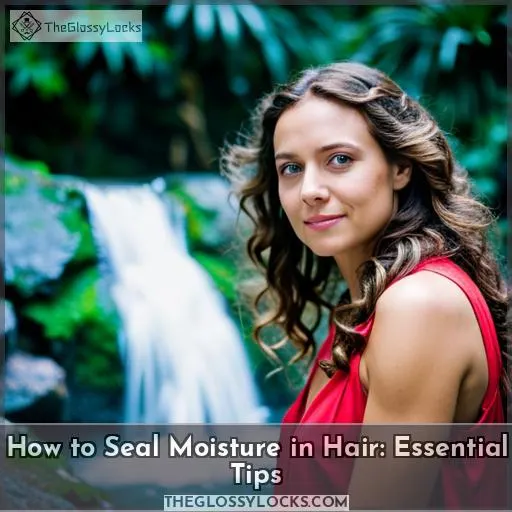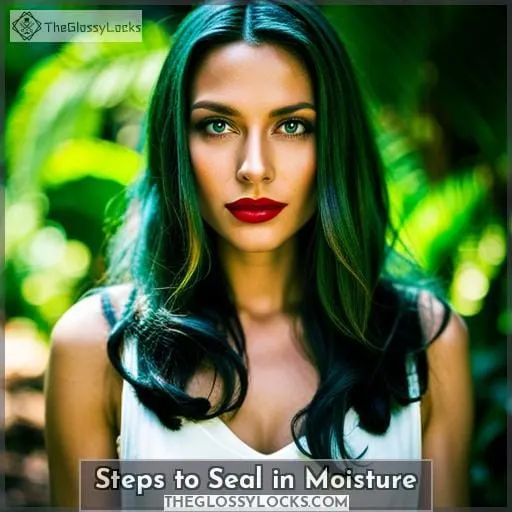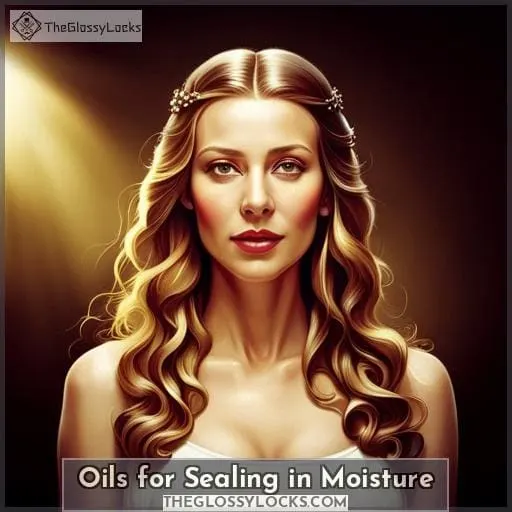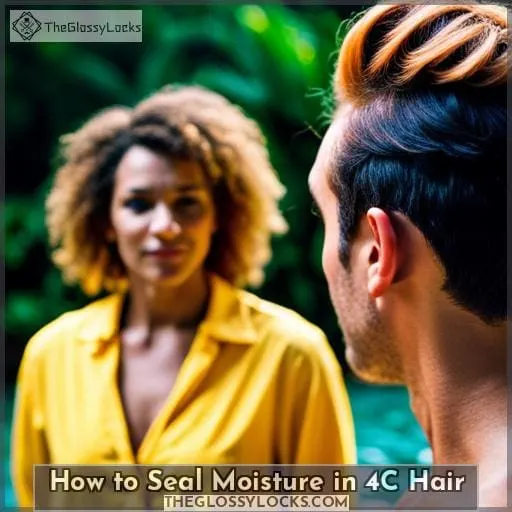This site is supported by our readers. We may earn a commission, at no cost to you, if you purchase through links.
 Are you struggling to retain moisture in your hair? Sealing it in is the key! Applying products with water-based ingredients and oil can help keep your locks hydrated and healthy.
Are you struggling to retain moisture in your hair? Sealing it in is the key! Applying products with water-based ingredients and oil can help keep your locks hydrated and healthy.
Here are some essential tips on how to effectively seal moisture into natural hair. First off, understanding what sealing means is paramount for getting this process right: it involves creating an impermeable barrier around each strand of your mane that prevents both air and liquid from passing through.
This helps lock in existing moisture while also preventing further drying out or breakage due to environmental factors like wind or sun exposure.
So now that we’ve got the basics covered, let’s move onto discussing different techniques for sealing our tresses – specifically those tailored towards 4C curls as well as low porosity and high porosity textures.
Table Of Contents
- Key Takeaways
- What Does Sealing in Moisture Mean?
- Steps to Seal in Moisture
- The LOC Method for Sealing in Moisture
- Differences Between Sealing Hair and Moisturizing It
- Oils for Sealing in Moisture
- How to Seal Moisture in 4C Hair
- How to Seal Moisture in Low Porosity Hair
- How to Seal Moisture in High Porosity Hair
- Preparing Your Hair for Sealing
- How Often Should You Seal in Moisture?
- Conclusion
Key Takeaways
- Sealing moisture in hair helps prevent moisture loss and protects against environmental factors.
- Use water-based products and oils to seal in moisture and nourish the hair.
- Adjust sealing routine based on hair texture and needs, using methods like LOC or LCO.
- Different oils have unique benefits for different hair types, so choose oils based on hair type and porosity.
What Does Sealing in Moisture Mean?
Maintaining moisture in your hair is essential for healthy and long-lasting results. Sealing in the moisture helps to protect it from evaporating, which can lead to breakage and dryness. By understanding the importance of sealing your natural hair, you can keep it looking and feeling its best with minimal effort.
Importance of Moisture in Hair
You need to keep your hair hydrated and healthy by regularly moisturizing and providing a barrier against water loss. Benefits of maintaining hydration in hair include decreased breakage, increased shine, improved manageability, better style retention, and overall healthier-looking locks.
Hair moisture tips include choosing shampoos with nourishing ingredients such as aloe vera or shea butter, which will help replenish moisture levels. Applying a leave-in conditioner after shampooing and using natural oils like olive oil or coconut oil to seal the cuticle layer from losing too much moisture are also recommended.
To avoid depleting essential nutrients from strands, it is advisable to minimize the use of heat styling tools whenever possible. Additionally, incorporating deep conditioning treatments every two weeks can provide an extra boost of hydration that will last longer than daily spritzing routines alone.
Understanding the importance of moisture in your haircare routine is paramount if you want to achieve optimal results when it comes to promoting strong growth and keeping tresses looking their best!
Benefits of Sealing in Moisture
By sealing in moisture, you can help protect your hair from damage and ensure it stays healthy and hydrated. The benefits of sealing include improved hair texture, increased shine, reduced breakage risk, and strengthened cuticles to lock in moisture longer term.
Sealing techniques involve using oil or butter-based products like extra virgin coconut or olive oil, Jamaican black castor oil, jojoba, grapeseed oil, fractioned coconut oil, shea butter, etc.
Experts suggest experimenting with the LOC (liquid-oil-cream/butter) or LCO (liquid–cream/butter–oil) methods to find which one works best for individual needs. It is also important to adjust the moisturizing routine based on unique textures and requirements.
Regularly spritzing water helps maintain moisture levels while balancing protein and moisture is a must for high porosity locks! Understanding your own needs when developing an effective routine that caters specifically to them will be key in keeping your strands nourished all year round!
Steps to Seal in Moisture
When it comes to sealing in moisture for natural hair, proper hydration and a nonporous coating are essential. To achieve the best results, spritz your hair with water or use a water-based product first, and then apply an oil barrier followed by butter-based products with butter as the main ingredient.
These techniques can help keep your hair healthy and moisturized while preventing breakage and aiding in length retention.
Spritzing Hair With Water or Using a Water-Based Product
Spray your hair with water or apply a leave-in conditioner to provide initial hydration and get your natural locks ready for sealing. Water-based products, such as leave-in conditioners, help moisturize the hair. Oils like extra virgin coconut oil act as an effective barrier against moisture loss.
Sealing with butter can make the hair feel soft. However, when looking for prolonged effectiveness of sealing, it is recommended to use specific oils like Jamaican black castor oil. Grapeseed and fractioned coconut oil offer both moisturizing and protective benefits that help retain moisture in the shafts.
Sealing With an Oil
After moisturizing, slather your locks with an oil to create a powerful barrier that will trap hydration in for hours! Choosing the right oil is essential. Natural options like extra-virgin olive or coconut can be effective. Shea butter and Jamaican black castor are also great sealing oils.
Benefits of sealing include hair moisture retention and preventing breakage while supporting length retention.
Sealing Again With a Butter
For an extra bit of moisture, butter-based products can help seal in the goodness. DIY sealing with butter is easy and beneficial: use shea or cocoa butters for softness; Jamaican black castor oil and jojoba are excellent for sealing; grapeseed oil and fractionated coconut work to both moisturize and seal.
Butter-based products with it as the first ingredient make hair feel soft, while twice-over application may be necessary on porous hair.
The LOC Method for Sealing in Moisture
The LOC Method is a popular hair care technique for sealing in moisture. It combines liquid, oil, and cream or butter to provide your natural hair with the hydration it needs while also preventing water loss from evaporation.
Liquid (Water or Water-Based Product)
Drench your mane with a liquid, such as water or a water-based product, to lock in lushness. Water-based products can provide extra hydration and protection against moisture loss. For natural hair care routines, adding these into the mix helps ensure adequate moisture retention.
Sealing with butter is also beneficial for softening and sealing in moisture while protecting from breakage.
Oil
To reap the benefits of sealing in moisture, apply an oil like extra-virgin coconut or olive oil to lock it into your hair. Oils act as a barrier that retains moisture within the shaft and helps prevent breakage caused by dryness.
Butter-based products can also provide softness while sealing, with shea butter being especially popular because of its smooth texture and natural scent.
Selecting specific oils such as Jamaican black castor oil or jojoba for their individual properties is often recommended too.
Don’t forget to ignore myths on oils not penetrating hair; using them correctly gives you all needed advantages!
Cream or Butter
Try using a butter-based product to seal in moisture – like shea butter – and you’ll find it’ll leave your hair feeling soft.
Creams or butters can be used as part of a hydration technique, such as the LCO method, for natural haircare needs.
Sealing with oil beforehand helps lock in the moisture protection before sealing with either cream or butter-based products afterward.
The latter acts as an effective barrier against water loss while simultaneously making hair feel softer and look shinier!
To get optimal results when applying oils followed by creams/butters, experiment with different combinations to see what works best for your texture needs – some may need daily sealing while others less frequently.
Differences Between Sealing Hair and Moisturizing It
The purpose of moisturizing and sealing hair is integral steps in a natural hairstyling routine. Moisturizing helps add hydration to your strands while sealing acts as a barrier against water loss, locking in the moisture already present.
Both processes work together to keep your hair looking healthy and full of life.
Purpose of Moisturizing
It’s important to regularly moisturize natural hair in order to keep it healthy and strong. Hydration is key for preventing breakage and allowing the hair to reach its full potential length.
Moisturizing products, like water-based leave-in conditioners, help keep your locks hydrated. Sealing with oil or butter forms a protective barrier that helps retain moisture within the shafts of each strand.
This method also prevents damage from environmental factors, such as heat and humidity, which could strip away essential oils needed for growth support.
Regularly using these techniques will ensure your natural tresses remain healthy by providing them with the nourishment they need!
Purpose of Sealing
Let your locks thrive by coating them with an oil barrier, like a protective shield against the drying elements. Sealing in moisture is essential for healthy hair and helps to maintain its natural texture.
A combination of water-based products and oils can be used to effectively seal in moisture without weighing down the hair. Extra virgin coconut or olive oil are great options that provide deep conditioning benefits while sealing out any excess water from escaping too quickly.
Experimenting with different sealing techniques will help you find which method works best for your individual needs. This includes variations between daily or weekly routines depending on how porous your hair is naturally.
Oils for Sealing in Moisture
Are you looking for the best oils to seal moisture in natural hair? Different oils offer different benefits and can be suitable for different hair types.
Benefits of Different Oils
Discover the nourishing and protective power of different oils for your hair, from extra-virgin coconut oil to shea butter! Oil is an essential part of any hair care routine as it helps retain moisture in the strands while also providing a barrier against water loss.
Different types of oils can be used depending on individual needs and preferences. For instance, extra-virgin coconut or olive oil are perfect for sealing in moisture, while grapeseed oil offers both moisturizing and sealing benefits.
DIY recipes such as whipped cocoa butter make use of these beneficial ingredients, offering unique ways to create custom products tailored specifically towards one’s own hair type. With expert recommendations like Rochelle Graham’s LOC/LCO method, you can explore which combination works best for you.
Keep experimenting until you find what suits yours best; then enjoy softness and shine thanks to these brilliant oils.
Suitable Oils for Different Hair Types
Depending on your hair type, different oils can help you retain moisture and prevent breakage. For low porosity hair, extra-virgin coconut or olive oil is suitable for sealing to create a barrier against water loss.
Shea butter and similar products are effective for high porosity strands that require more intense moisturizing steps. Sealing with butter such as mango or cocoa makes the locks feel soft without making them greasy, while grapeseed oil has both hydrating and sealing properties.
How to Seal Moisture in 4C Hair
Sealing in moisture for 4C hair can be a challenge. To achieve the best results, it is important to understand the unique needs of this type of hair and use specific techniques that will help ensure lasting hydration.
In this article, we will discuss some tips on how to properly seal in moisture for 4C hair.
Challenges of Sealing 4C Hair
Gearing up for sealing your 4C hair? Understand the challenges you might face first.
Hydration is key to maintaining healthy and moisturized 4C hair, however, excessive hydration can lead to issues such as product build-up on the scalp or dryness in areas that have been oversaturated.
Porosity of this type of natural hair is generally high, which means it may require more frequent sealing than other types of curls. Moisture retention presents an added challenge due to its propensity for water loss from evaporation.
Protective styling techniques should be used where possible when trying to retain moisture between washes. Also, consider a regular deep conditioning routine with products specifically designed for hydrating and restoring porous strands.
Achieving balance between proper hydration while preventing excess buildup requires knowledge about how much each strand needs.
Tips for Sealing 4C Hair
To maximize your 4C hair’s shine and length, you’ll need to lock in its hydration with the right products.
- Hair Sprays – Aerosol-free sprays that can spritz water or a leave-in conditioner onto hair for initial moisturizing.
- Butters – Butter-based products like Shea butter, as well as extra-virgin coconut oil or olive oil, that act as barriers against moisture loss.
- Oils – Specific oils such as Jamaican black castor oil, jojoba, and fractionated coconut oil all help seal in moisture while also moisturizing.
- Protective Styling & Nighttime Routines – Use protective styles at night (e.g.
Incorporating these tips into your routine will ensure maximum hydration retention for long-lasting results!
How to Seal Moisture in Low Porosity Hair
If you have low porosity hair, you know that it can be difficult to get moisture into and keep it there. Low porosity hair has tightly bound cuticles which prevent water from easily penetrating the strands, making traditional moisturizing techniques ineffective.
Fortunately, there are specific sealing methods designed for this type of hair that will help lock in hydration while also protecting your tresses from environmental damage.
Characteristics of Low Porosity Hair
You’ll know you have low porosity hair when it’s resistant to absorbing and retaining moisture. Low porosity hair tends to be naturally oily, with a smooth surface that makes it difficult for water or other products containing moisture to penetrate the shaft.
Sealing techniques such as using oils, butters, and leave-in conditioners can help retain hydration in your strands by creating a protective barrier against evaporation. Additionally, deep conditioning treatments are beneficial for replenishing lost nutrients within the cuticle of low porosity tresses.
Water-based products should also be included in your routine since they’ll not only moisturize but seal the ends too! Using specific oils like Jamaican black castor oil or jojoba is an excellent way of locking in essential hydration while sealing with butter helps make hair feel soft all day long.
Understanding your own level of porosity is key when figuring out how best to care for your unique locks; so take some time and experiment until you find what works best!
Techniques for Sealing Low Porosity Hair
Using the right products and techniques, you can help lock in hydration for your low porosity hair. Start with a water-based moisturizer followed by an oil or butter to seal. Choose unrefined oils like extra virgin coconut or olive oil to effectively maintain moisture levels.
For added protection, consider using Jamaican black castor oil or jojoba as they’re especially great for sealing in moisture. Grapeseed and fractioned coconut oils work well too! Experiment with different combinations of liquid, cream/butter, and then finishing off with an oil – known as the LCO (liquid-cream/butter-oil) method – until finding what works best for your hair texture needs.
Balancing protein and moisture is key, so don’t forget to adjust your routine accordingly! Your strands will thank you when they receive all the love they need from these effective sealing methods made just for low porosity hair!
How to Seal Moisture in High Porosity Hair
If you have high porosity hair, it is likely dry and prone to breakage due to its raised cuticles. The good news is that sealing in moisture can help! Techniques such as using water-based products, oils, butters, and specific oils like Jamaican black castor oil or jojoba are all effective for locking in moisture on high porosity strands.
Characteristics of High Porosity Hair
High porosity hair is characterized by its ability to quickly absorb and lose moisture, making it especially important to take extra care when maintaining hydration. Sealing with butter-based products can help keep high porosity hair moisturized for longer periods of time, while sealing twice with oil and butter may be necessary for porous hair types.
Specific oils like Jamaican black castor oil or jojoba are great at locking in moisture, while shea butter helps create a protective barrier around the strands. It’s also helpful to use water-based products as well as spritzing your locks regularly with water throughout the day.
Experimenting with different methods such as LOC (liquid, oil cream/butter) or LCO (liquid, cream/butter, oil) will help you find what works best for your own unique needs and texture type! With proper care techniques that include hydrating properly through moisturizing treatments combined with effective sealing practices.
Techniques for Sealing High Porosity Hair
To keep your high porosity hair hydrated and healthy, try slathering it with luxurious oils for an ultra-smooth finish that’ll leave you feeling like a million bucks! Sealing techniques, such as extra-virgin coconut oil, Jamaican black castor oil, jojoba oil, and fractioned coconut, can all be used to lock in moisture.
If you have porous hair, care is key. Sealing twice with shea butter or other butter-based products may help maintain optimal levels of moisturization. For those needing daily sealing, butters are great for sealing while providing softness at the same time.
Grapeseed and olive oils also make excellent sealants because they both moisturize and seal simultaneously. Balancing protein and moisture is essential for high porosity solutions, so understanding your specific needs is vital when adjusting routines accordingly.
Preparing Your Hair for Sealing
Before sealing in moisture, it is important to prepare your hair. This involves ensuring that all product residue has been removed from the hair and detangling and sectioning the strands for easier application of products.
Ensuring Hair is Product-Free
Before sealing, make sure to carefully remove all product residue from your hair with a gentle clarifying shampoo. Product build-up can leave your scalp feeling dry and itchy, while also preventing natural oils from moisturizing the strands properly.
A good cleansing session is essential for a healthy scalp and hair moisture retention.
Regular use of natural oil treatments or conditioners will help nourish the strands without leading to too much buildup over time. Clarifying shampoos are designed specifically for removing these residues that accumulate on our locks after styling products have been used.
Detangling and Sectioning Hair
Once you have product-free hair, detangle and section it to make sealing easier. Use techniques like finger combing or a wide-toothed comb to reduce breakage.
Section your hair into four quadrants for better hydration and moisture retention. Apply a moisturizing product with water as the main ingredient before sealing to achieve maximum hydration for your hair type.
This will allow oils or butters used for sealing to penetrate deeper into the scalp’s layers, helping retain more moisture in each strand over time.
When choosing products to nourish your strands and provide an extra layer of protection against water loss, consider options like coconut oil, olive oil, and jojoba oil. These oils are great for maintaining optimal hair health. Shea butter is also an excellent choice as it deeply penetrates and hydrates the scalp.
How Often Should You Seal in Moisture?
Whether you have natural, curly hair or a relaxed style, sealing in moisture is essential for healthy and strong tresses. Depending on your hair type and needs, the frequency of sealing can vary. It’s important to adjust your routine accordingly so that you get the best results from moisturizing and sealing treatments.
Frequency of Sealing
Discover how often you should be sealing in moisture for your natural hair to keep it healthy and hydrated! Depending on the porosity of your hair, the daily vs.
Seasonal changes also mean you may need to adjust accordingly; consider adding a nighttime routine during colder months or using heavier products like butter or oil-based mixtures as needed.
Product selection is key: opt for water-based products first, followed by an oil-sealer, and then add a protective sealant with butter if needed. This is especially important when dealing with high porosity locks that tend to lose moisture quickly.
With proper product selection and frequency of use tailored towards individual needs, sealing in moisture can help protect against breakage while providing desired length retention goals!
Adjusting Based on Hair Type and Needs
Adjusting your routine to suit your hair type and needs is key for achieving consistent hydrated locks. Scalp massages, deep conditioning, moisture retention products, and water-based products are all important components of a customized routine based on the individual’s porosity level.
Depending on their texture, some may require daily sealing while others can get away with less frequent maintenance. It’s all about finding what works best for you! To ensure optimal hydration levels without overloading the scalp or leaving dry patches behind, regularly monitor porosity levels.
A good rule is to balance protein and moisture in high porous hair. This allows long-lasting results that keep strands healthy from root to tip! Ultimately, by taking into account one’s own unique characteristics when caring for natural hair, you can create an individualized plan that yields beautiful results!
Conclusion
If you’re looking to maintain healthy, long natural hair, it’s essential to understand how to seal in moisture. Take Amanda, for example: she began by spritzing her hair with water or using a water-based product to moisturize it.
Then, she followed up with an oil to act as a barrier against water loss. She found the best results using extra-virgin coconut or olive oil. Amanda even experimented with the LOC (liquid, oil, cream/butter) or LCO (liquid, cream/butter, oil) methods to find what works best for her hair.
It’s also important to adjust your routine based on your hair’s texture and needs. Balancing protein and moisture is crucial for high porosity hair. With the right products, techniques, and understanding of your hair’s needs, you can easily learn how to seal moisture in your hair and enjoy its health and growth.













